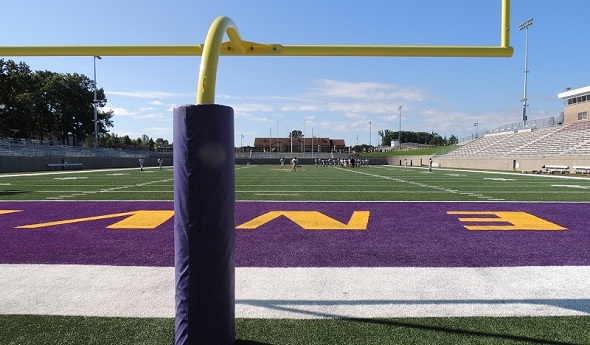
A Legacy Begins in Greenville
August 24, 2012
By Geoff Kimmerly
Second Half editor
GREENVILLE – Curtis Heppe has no idea what to expect, but a few guesses and a dream or two of how it will feel tonight to lead his teammates into Greenville's Legacy Field for the first time.
“It’s going to be electric, for sure. It’s a new vibe. It’s high-tech there,” the Yellow Jackets quarterback said Thursday after his team’s final preseason practice.
Those expectations are shared by a community that will be cheering on the local team in a new home after nearly a century at the legendary Black Field.
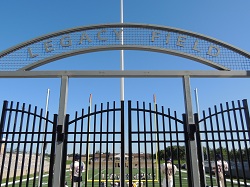 Workers put the finishing touches on the near-$7 million facility this week in advance of the season's first varsity game, tonight against rival Belding. Legacy Field officially opened for Wednesday’s freshman game, and Heppe said that even for that lower-level appetizer, the stadium began to come alive.
Workers put the finishing touches on the near-$7 million facility this week in advance of the season's first varsity game, tonight against rival Belding. Legacy Field officially opened for Wednesday’s freshman game, and Heppe said that even for that lower-level appetizer, the stadium began to come alive.
“We’ve just wanted Friday night to come. To get in and see how intense, how nice this place is,” he said. “Coming out of that tunnel, seeing our fans, it’s going to be the best feeling.”
Tonight’s grand opening will be the culmination of efforts from not just administrators, but students and community members as well – down to the name of the stadium itself.
“Legacy Field” was selected by Greenville’s school board. But it came as a suggestion from the school’s student council, which took submissions from classmates and then with faculty and administrators whittled the list to three favorites – Stinger Stadium and Community Field were next on their list.
But that’s just one way Legacy Field is a blend of old and new and ideas from all over town.
“In development, (it’s been) probably 10 years. We’ve been talking about it ever since I’ve been here, that one day we’d be able to do this,” said Greenville athletic director Brian Zdanowski, who is entering his 15th school year at that post. “It came through strategic planning. It came through community input. And then ultimately, our board bought in that there was enough interest in the community.”
Deeply rooted
A walk through Legacy Field is a history lesson. But first, an explanation of the Yellow Jackets’ past.
Black Field had served as the team’s home since 1916. It is nestled downtown next to Greenville’s former high school, which is now a library.
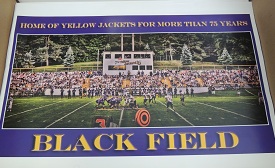 The current high school, about 1.5 miles northwest, was built in 1963. Football teams continued to make the short trip for home games.
The current high school, about 1.5 miles northwest, was built in 1963. Football teams continued to make the short trip for home games.
Black Field has its charms. With no track surrounding the field like at many multi-purpose stadiums, fans are only a few yards from the sideline. And all of that history added to the mystique for the latest players to wear the uniform.
The field also has had peculiarities. Zdanowski said at one point, the end zones were elevated in the corners. And the field wasn’t always square – a 10-yard penalty might measure 11 on one side of the field but only nine yards on the other.
But after just about every home game, students met for a bonfire on the grounds, an extension of the celebration by neighborhoods that surround Black Field and embraced the team for decades.
“It was the typical focal point of the community,” Zdanowski said.
Some things old, many new
Playing on Black Field was special, Heppe added. But he's equally if not more excited to be part of this new legacy. And architects made sure to bring that community feel to the new home this fall.
Destruction and construction began May 2, the day after last season’s final girls tennis match. The courts formerly sat in what is near the south end zone, and were moved closer to the track and soccer facility.
Amenities at the Yellow Jackets’ new football home are comparable to a college stadium’s, starting at the north side of the field.
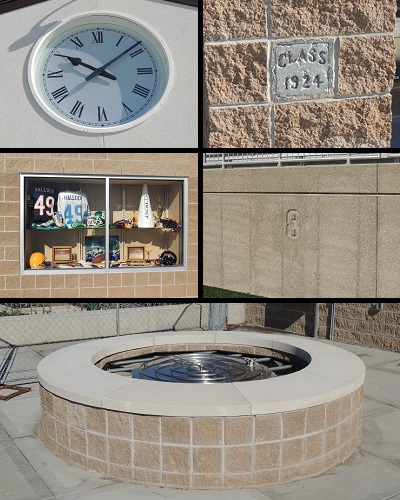 Players will enterthrough a tunnel that pours into the field like that of a miniature Spartan Stadium. Surrounding the tunnel are expansive locker rooms both for the home team and visitors, a similarly expansive training room and officials area and plenty of storage that will allow Greenville’s entire football program to be housed under that one roof. Unlike Black Field, tucked neatly among its neighbors, Legacy Field has plenty of parking and lighting, and builders were able to make that possible while also keeping intact a group of large oak trees near the south gate.
Players will enterthrough a tunnel that pours into the field like that of a miniature Spartan Stadium. Surrounding the tunnel are expansive locker rooms both for the home team and visitors, a similarly expansive training room and officials area and plenty of storage that will allow Greenville’s entire football program to be housed under that one roof. Unlike Black Field, tucked neatly among its neighbors, Legacy Field has plenty of parking and lighting, and builders were able to make that possible while also keeping intact a group of large oak trees near the south gate.
The turf is synthetic, like that played on by all but one member of the Yellow Jacket’s O-K Bronze conference. The difference from many is that the field has been dug out from the surrounding property, making it even more a focal point for those who will occupy the roughly 4,000 seats in the surrounding cement bowl. (The removed dirt was used to build two Little League fields on another part of the property.)
The sound system is of course state-of-the-art, and the press box, concessions area and restrooms also are equally expansive. But what locals should notice most are the throwbacks to the past that dot every corner of their new home.
Cut into the brick work near the concession counter is a block from Black Field that had been dedicated by the school’s class of 1924. Atop the building is the Centennial Clock, 100 years old this year, which formerly hung at the entrance the old school and was donated by the class of 1912. It has been housed by Greenville’s museum until being re-donated to the school district to become part of the stadium.
Molded into the cement walls on the west and south sides of the field are the numbers formerly worn by players Henry Loding and Greg Blumberg. Both died from football-related injuries; Loding in 1906 and Blumberg in 1977. Two trophy cases are cut into the stone on the facing of the press box, including one featuring mementos celebrating alum and former Detroit Lions tight end Ty Hallock.
Another addition of historical significance will come later. The school’s first Hall of Fame class will be inducted before the Sept. 7 game, and that display will be housed near the south ticket area so residents and fans can check it out without having the enter the stadium itself.
And one last thing was added to keep with tradition. To the west of the concession area, but within the stadium fence, sits a large gas fire pit for those postgame gatherings – plus a sound system where students can plug in their mp3 players.
“We said we’re not forgetting our past, but we’re embracing our future,” Zdanowski said. “I’m sure a lot of people have said that before. So we really wanted to make sure we got community input on it and do as much as we could to replicate Black Field. … And I think we won some people over. We really wanted to do what we said (we’d do).”
PHOTOS: (Top) Greenville's junior varsity ran through drills during a morning session at Legacy Stadium, which opened this week. (Top middle) The ticket area and gate for fans sit on the south side of the field. (Middle) A poster given out last season celebrated the final to be played at Black Field. (Bottom middle) A number of pieces of Black Field's past and Greenville tradition were brought over to or included in Legacy Field, including Centennial Clock, which formerly was part of the old school.
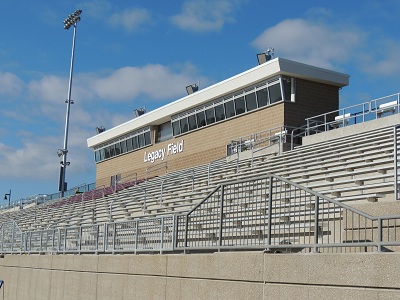
Legacy Field's press box is split into areas for game workers, coaches and media with a roll-up door for film crews.
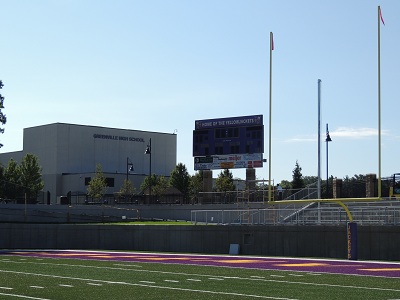
Legacy Field sits between Greenville's high school and middle school and adjacent to its soccer and track facilities.
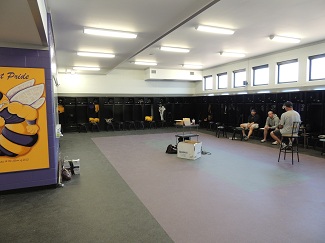
Coaches met in the spacious varsity locker room Monday morning. Junior varsity and freshman locker rooms are connected by a hallway with access to storage areas and the coaches' office.
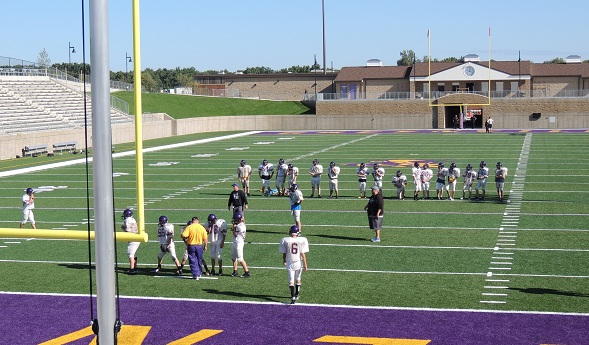 Players will enter Legacy Field through a tunnel at its north end. Above sits the concession area and restrooms, and the Centennial Clock that once ticked in the old Greenville school.
Players will enter Legacy Field through a tunnel at its north end. Above sits the concession area and restrooms, and the Centennial Clock that once ticked in the old Greenville school.
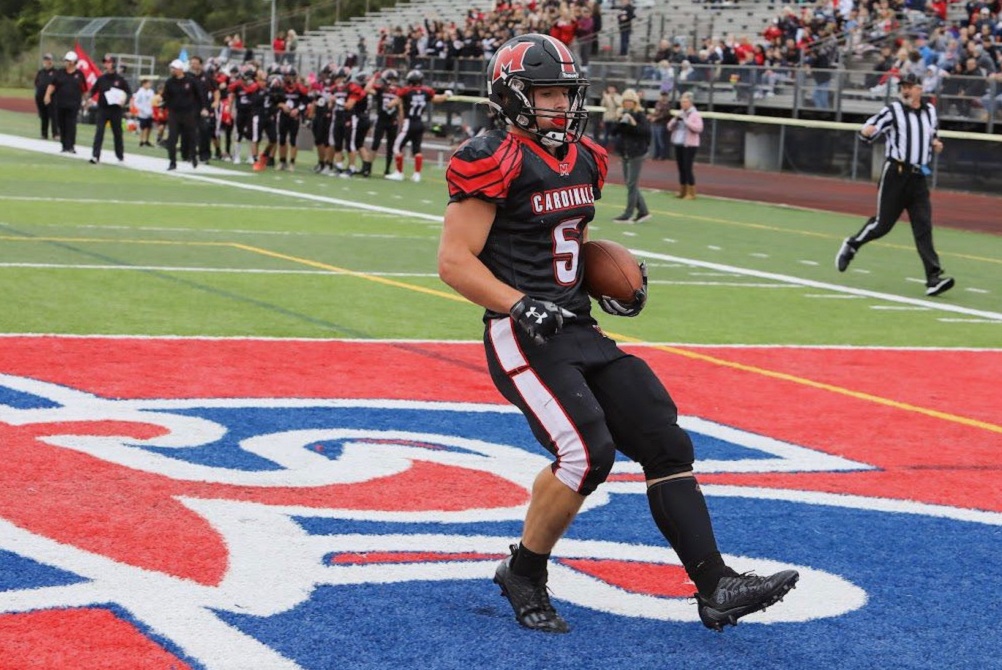
Haisenleder Provides Lift-Off as Revitalized Cardinal Mooney Continues Rise
By
Paul Costanzo
Special for MHSAA.com
November 9, 2022
Brendan Haisenleder understands the specialness of his senior football season, which came to an end Friday with a 42-21 Division 8 District Final loss to Clarkston Everest Collegiate.
 He is well aware that what he accomplished at Marine City Cardinal Mooney was extraordinary.
He is well aware that what he accomplished at Marine City Cardinal Mooney was extraordinary.
But when asked to recap it, none of the personal milestones came up.
“It’s really awesome seeing the program and how it used to be a couple years ago and how it’s turned around,” Haisenleder said. “Just seeing the growth as a program, going from having a roster of 15 kids and now we’re at 30. It’s really awesome, and I’m really proud of how far the Mooney program has come.”
He’s certainly not wrong. Mooney was 8-3 this season, winning a playoff game for the first time since 2011 when the team was playing in the 8-player format. The first-round victory against Marlette was the first 11-player playoff win for the Cardinals since 2005.
They won the Detroit Catholic League Intersectional 2, and the 15 wins over the past two seasons were more than the previous six seasons combined.
“I think that one big thing is the work in the offseason that all of the kids put in and all of the coaches,” Haisenleder said.
 “We were getting a lot of stuff we needed to get done going into the season, we took everything very seriously, and we played very hard and physical on gamedays.”
“We were getting a lot of stuff we needed to get done going into the season, we took everything very seriously, and we played very hard and physical on gamedays.”
But it’s undeniable that Haisenleder was at the heart of it, and his statistics tell quite a bit of the story.
He rushed for 2,302 yards, easily setting a new Mooney season record, and scored 30 offensive touchdowns. On defense, he recorded 148 tackles and five interceptions.
Mike McAndrews, Mooney’s director of admissions and boys basketball coach, didn’t mince words when he tweeted about Haisenleder’s status in Mooney history.
“The best football player to ever wear a Mooney uniform,” McAndrews wrote, tagging Haisenleder. “He took this program to new heights. He will be playing on Saturdays next year and will make a college coach very happy.”
Haisenleder wouldn’t say that he was surprised by his success this season. But he did admit that he exceeded his own very high expectations. By Week 4, he already had eclipsed the 1,000-yard mark.
“When I play, I have a lot of confidence,” he said. “I put a lot of pressure on myself that I have to put the work in so I can do the best I can to help my team. One of the goals I had was to become the single-season rushing leader at our school. … My offensive line did a great job.”
Haisenleder’s success has led to college interest. He has six offers to play at the next level, four from NAIA schools and two from Division III.
At 5-foot-8, 190 pounds, he knows he’s fighting an uphill battle in that regard, but it’s made him even more driven to succeed.
“There kind of is a chip on my shoulder,” he said. “Seeing guys that are very similar to me getting offers, and I think, ‘Man I’m right there.’”
The best football player to ever wear a Mooney uniform @BHaisenleder. He took this program to new heights. He will be playing on Saturdays next year and will make a college coach very happy. pic.twitter.com/vIaOWdhDVg
— Mike McAndrews (@CM_hoopsCoach) November 5, 2022
Haisenleder’s football idol is Barry Sanders, who he was able to meet at an event in October. The size is an immediate comparison to make, and it’s easy to see how any athlete – even if they were born six years after Sanders retired – could be engrossed by Sanders highlights. But it’s Sanders’ humility that Haisenleder most wants to emulate.
“One of my favorite things about him was how humble he was,” Haisenleder said. “When he would score, he would just hand the ball to the ref and act like he’d been there before. That’s another thing I take very big pride in.”
Haisenleder said he will now take more time to figure out what his next step will be, although things won’t really slow down much for him. Conditioning for basketball already has started.
He’s a guard on the Cardinals’ basketball team, and an outfielder on the baseball team. While football became his main focus as he neared high school, he said he loves all three.
It helps that all three teams are seeing quite a bit of success at Mooney, and that many of Haisenleder’s teammates overlap on all three.
“It is cool at a small school that a lot of the same guys play the same sports,” he said. “There’s a really big brotherhood between the same guys. The family never really changes that much, and we’re really growing in chemistry with one another.”
 Paul Costanzo served as a sportswriter at The Port Huron Times Herald from 2006-15, including three years as lead sportswriter, and prior to that as sports editor at the Hillsdale Daily News from 2005-06. He can be reached at [email protected] with story ideas for Genesee, Lapeer, St. Clair, Sanilac, Huron, Tuscola, Saginaw, Bay, Arenac, Midland and Gladwin counties.
Paul Costanzo served as a sportswriter at The Port Huron Times Herald from 2006-15, including three years as lead sportswriter, and prior to that as sports editor at the Hillsdale Daily News from 2005-06. He can be reached at [email protected] with story ideas for Genesee, Lapeer, St. Clair, Sanilac, Huron, Tuscola, Saginaw, Bay, Arenac, Midland and Gladwin counties.
PHOTOS (Top) Cardinal Mooney’s Brendan Haisenleder finishes one of his 30 touchdowns this fall. (Middle) Haisenleder works to break a tackle during a Week 8 win over Whitmore Lake. (Photos by Lindsey VanTiem.)

